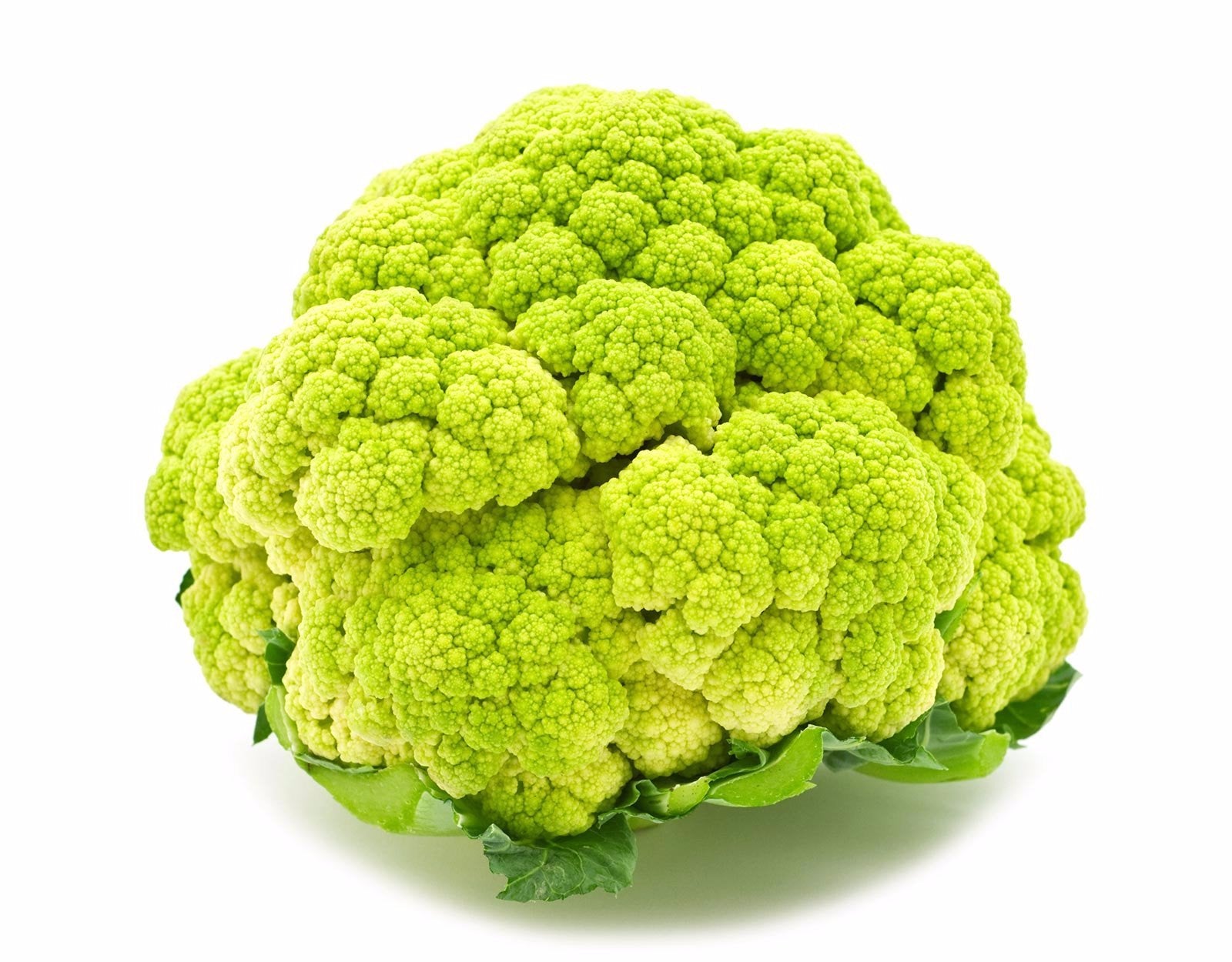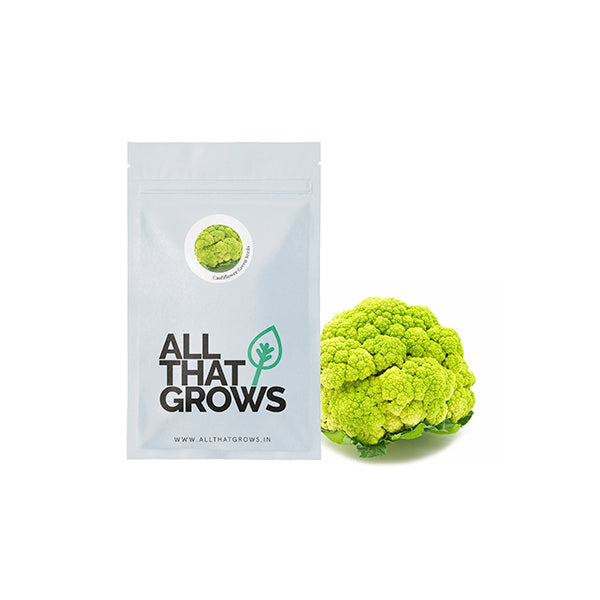



- SOWING
TIMESep - Dec
- Sowing
DistancePlant to plant - 24" / Line to line - 24"
- Fruit
Weight1-1.2 kgs
- Fruit
ShapeDome, mildly hard and green
- Days to
maturityLate maturity, after 180-190 days from sowing.
- Details
- How to sow
- Reviews
Although it is the white cauliflower which is the most commonly available, the green cauliflower is also now catching up in popularity. Green Cauliflower too belongs to the Brassica oleracea family but the group it belongs to is called the Botrytis. The green cauliflower is sometimes called Broccoflower because of its resemblance with Broccoli. The green cauliflower became commercially available in the U.S and Europe first in the 1990s before finding its place in vegetable markets around the world. Similar in taste and health benefits, the green cauliflower is super healthy with only a slight difference in its appearance which includes a fractal spiral curd, only slightly different. Cauliflower is a vegetable with many health benefits. It can be cooked in a variety of ways which includes boiling, steaming, frying, blanching, pickling, roasting, baking, and cooking with other vegetables. It can even be eaten raw. The vegetable is very low in fat and calories and is rich in Vitamin C (about 20% of RDA can be covered with a good serving of cauliflower), many of the B vitamins and Vitamin K.
Cauliflower is a biennial with 180-190 days maturity from the sowing period. But easy to maintain plant, it is a gorgeous addition to any vegetable garden. So shop our seeds right away.
Planting instructions
Cauliflower seeds need to be sown half an inch deep into the soil. Make sure that the temperature of the soil is between 21°C to 23°C for the seeds to germinate well.
If you are starting indoors, then about 4 weeks from planting, you will need to move the seedlings outdoors for transplanting. Transplants should have at least 3 leaves. Also, look for a small bud in the center of the plant.
Once you have transplanted them, thin the seedlings to 24 inches between plants and 36 inches between rows.
Growing Requirements
Pests & Diseases
Pests: Cabbage Maggots, Cabbage Loopers, Cabbage Worms, Aphids, Flea Beetles. Diseases: Black Leg, Black Rot, Club Root. Watering the plants in the morning helps to avoid fungal diseases. Companion plants significantly reduce incoming pests on your crops. Watering down the plants with a strong stream of water followed by an application of diluted neem or castor oil on the pest-affected parts of the plant will help to get rid of them.
soil
Fertile, well-drained, moist soil with plenty of rich organic matter and a pH level of 6.5 to 6.8.
spot
Choose a spot that gets at least 6 hours of sunlight in a day.
Temperature
The ideal germination temperature for Cauliflower is between 10°C to 26°C.
Watering
Water the plants regularly, especially while they are in the germination phase. Ensure that the soil has enough moisture. The best way to water cauliflower is by using a drip irrigation system.
how to harvest
Cauliflower is usually ready for harvest in about 180-190 days from harvesting, depending on whether you are growing from seeds or transplants. Ideally, the heads should be 6-8 inches in diameter before you harvest them for consumption. To harvest, cut the heads with a large knife leaving a few leaves around the head to keep it protected.
Even if the heads are too small and have already started to open up, it’s best to harvest them since they will not grow any further. If the cauliflower heads appear too coarse, they have matured more than necessary and should be thrown out.
To store your cauliflower heads, simply put them in a bag and keep them in the refrigerator. They should remain fresh for at least a week. However, if you are planning to store for a long period of time, you can keep them in the freezer or pickle them.

The productiveness of any seed we sell is subject to your local climatic conditions*, the sowing method you adopt, and your commitment to the planting process. We give no warranty, expressed or implied, and are in no way responsible for the produce.
Please note that all our seasonal recommendations/ sowing information is as per the local climatic conditions. *For more information on the optimum conditions required for growing seeds in your region, please contact us at, hello@allthatgrows.in or Whatsapp us at, +91 8544865077
Questions & Answers
Have a Question?
Be the first to ask a question about this.




Cauliflower Green Seeds
Seed Type : Non-Hybrid, Open Pollinated and Non-GMO
Plant : Late maturity, after 180-190 days from sowing.
Curd size : large, 1.2-1.3 kgs in weight
Curd colour : Green
Although it is the white cauliflower which is the most commonly available, the green cauliflower is also now catching up in popularity. Green Cauliflower too belongs to the Brassica oleracea family but the group it belongs to is called the Botrytis. The green cauliflower is sometimes called Broccoflower because of its resemblance with Broccoli. The green cauliflower became commercially available in the U.S and Europe first in the 1990s before finding its place in vegetable markets around the world. Similar in taste and health benefits, the green cauliflower is super healthy with only a slight difference in its appearance which includes a fractal spiral curd, only slightly different. Cauliflower is a vegetable with many health benefits. It can be cooked in a variety of ways which includes boiling, steaming, frying, blanching, pickling, roasting, baking, and cooking with other vegetables. It can even be eaten raw. The vegetable is very low in fat and calories and is rich in Vitamin C (about 20% of RDA can be covered with a good serving of cauliflower), many of the B vitamins and Vitamin K.
Cauliflower is a biennial with 180-190 days maturity from the sowing period. But easy to maintain plant, it is a gorgeous addition to any vegetable garden. So shop our seeds right away.
Seed Type : Non-Hybrid, Open Pollinated and Non-GMO
Plant : Late maturity, after 180-190 days from sowing.
Curd size : large, 1.2-1.3 kgs in weight
Curd colour : Green
- SOWING
TIMESep - Dec
- Sowing
DistancePlant to plant - 24" / Line to line - 24"
- Fruit
Weight1-1.2 kgs
- Fruit
ShapeDome, mildly hard and green
- Days to
maturityLate maturity, after 180-190 days from sowing.
Planting instructions
Cauliflower seeds need to be sown half an inch deep into the soil. Make sure that the temperature of the soil is between 21°C to 23°C for the seeds to germinate well.
If you are starting indoors, then about 4 weeks from planting, you will need to move the seedlings outdoors for transplanting. Transplants should have at least 3 leaves. Also, look for a small bud in the center of the plant.
Once you have transplanted them, thin the seedlings to 24 inches between plants and 36 inches between rows.
Growing Requirements
Pests & Diseases
Pests: Cabbage Maggots, Cabbage Loopers, Cabbage Worms, Aphids, Flea Beetles. Diseases: Black Leg, Black Rot, Club Root. Watering the plants in the morning helps to avoid fungal diseases. Companion plants significantly reduce incoming pests on your crops. Watering down the plants with a strong stream of water followed by an application of diluted neem or castor oil on the pest-affected parts of the plant will help to get rid of them.
soil
Fertile, well-drained, moist soil with plenty of rich organic matter and a pH level of 6.5 to 6.8.
spot
Choose a spot that gets at least 6 hours of sunlight in a day.
Temperature
The ideal germination temperature for Cauliflower is between 10°C to 26°C.
Watering
Water the plants regularly, especially while they are in the germination phase. Ensure that the soil has enough moisture. The best way to water cauliflower is by using a drip irrigation system.
how to harvest
Cauliflower is usually ready for harvest in about 180-190 days from harvesting, depending on whether you are growing from seeds or transplants. Ideally, the heads should be 6-8 inches in diameter before you harvest them for consumption. To harvest, cut the heads with a large knife leaving a few leaves around the head to keep it protected.
Even if the heads are too small and have already started to open up, it’s best to harvest them since they will not grow any further. If the cauliflower heads appear too coarse, they have matured more than necessary and should be thrown out.
To store your cauliflower heads, simply put them in a bag and keep them in the refrigerator. They should remain fresh for at least a week. However, if you are planning to store for a long period of time, you can keep them in the freezer or pickle them.



 Sign In
Sign In








